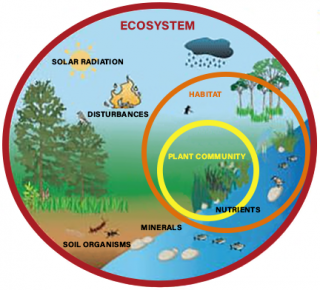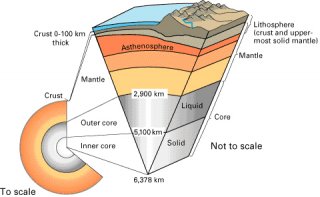How To Reduce Background Radiation
Radiation Facts
- Radionuclides tin can occur naturally or can exist man-fabricated.
- Natural radiation sources contribute over half of the annual radiations exposure for an average person in the U.s..
Radiations is a part of our day-to-day lives. It is a part of the air we breathe, the water we drink and the food we eat.
On this folio:
- Nearly Background Radiation
- What you can do
- Where to learn more
About Background Radiation
Background radiations is the radiation that is present in the natural environment. Natural background radiation is all effectually u.s., all of the time. It makes up over half of our yearly exposure to radiations. The amount of background radiation is different at every location. It depends on many factors, including:

Source: U.Due south. National Park Service (NPS)
- Radionuclides present in World'due south chaff.
- Radionuclides created by cosmic rays hit atoms in Earth'due south atmosphere. If we are closer to outer space, we are more likely to interact with these radionuclides.
- Human being activity and industry, including byproducts and wastes from processes like water filtration and treatment.
- Weather condition, which tin assist radionuclides from nuclear weapons testing settle back to Earth from the atmosphere.
Scientists report ecosystems to acquire how minerals and other chemicals, like radionuclides, motion through Earth's different natural systems. This research is called ecosystem science. Ecosystem science studies every part of the system, including the interactions betwixt water, air, country, plants, animals, and humans. Scientists study radionuclides as they move through ecosystems.
Radionuclides in Globe'south Chaff
Some radionuclides take been present in rocks since the formation of the World. All radionuclides go through radioactive decay until they achieve a stable state. Radioactivity is the process in which a radioactive element turns into another chemical element, releasing radiation in the process. Natural radionuclides found in the Earth'southward crust include uranium and thorium. As they decay, they get other radionuclides such every bit radium and radon. These radionuclides end up naturally in soil, water and air.

Rocks containing natural radionuclides are broken down into soil past the conditions, bacteria and fungi. When radionuclides are in soil particles, they can be blown around by wind. Some radionuclides deliquesce in water and end upwardly in surface or groundwater.
More one-half of the boilerplate annual radiation exposure of people in the U.s.a. comes from natural sources. The natural radionuclide, radon, is the largest natural source of exposure. Radon is a natural radioactive gas that gets into homes and buildings. Information technology is important to test your home for radon to reduce your exposure to radiation. Learn more than about RadTown'due south Radon in Homes, Schools and Buildings.
Radiations from Space
Almost 5% of the boilerplate almanac radiations exposure for people in the United States comes from outer space. Our solar system's dominicus, and other stars in the galaxy, emit a constant stream of cosmic radiations, which so regularly hits the World. When catholic rays collide with atoms, they tin make atoms radioactive. These radioactive atoms are called cosmogenic radionuclides. They are rare, but some of them do attain Earth's surface and mix with soil and h2o. Learn more than near Cosmic Radiations.
Cosmic radiation is the main source of carbon-14, which is used to date ancient artifacts. This technique is called carbon dating.
Radionuclides from Human Uses of Radioactive Textile
Most radioactive material in the environment comes from natural sources. Much smaller amounts of radionuclides come from sources adult by humans. For instance, uranium mines, nuclear power plants, and enquiry facilities that utilize radionuclides sometimes add pocket-size amounts of radionuclides to the ecosystem. For most people, the annual exposure from these sources is very depression. There may be a serious health chance just in certain areas where open uranium, hard rock metallic mines, other mineral mines or mining wastes are present.
- Nuclear weapons testing: Generally in the 1950s and 1960s, nuclear weapons tests released large amounts of radionuclides that spread and remained in ecosystems until the radionuclides decayed abroad. The Comprehensive Nuclear-Test Ban Treaty Organization (CTBTO)has a network of radionuclide monitoring stations that detect radionuclide particles and noble gases, similar xenon, which would indicate a nuclear test.
- Nuclear facility releases: The small-scale amounts of airborne radionuclides released from facilities that handle and procedure radioactive materials tin can get into the soil, water or air. The EPA regulates how much radioactive materials can exist released from these facilities. Learn more most Nuclear Ability Plants.
- Radioactive waste:Improper disposal of radioactive waste is another fashion radionuclides can enter an ecosystem. For example, water seeping thorough mining wastes tin can dissolve some radionuclides and carry them into the water system. Public water systems are carefully monitored by your state, and must meet federal standards, to make sure the drinking water is rubber.
What You Can Practice
- Get your water tested for radionuclides. If you employ water from a private well, you lot should become your h2o tested for radionuclides. Acquire more nigh Natural Radionuclides in Individual Well.
- Test your home for radon. Testing at home is easy. Many kinds of depression-cost radon test kits are available by telephone, online and in stores. If you prefer, you lot tin also rent a professional person to practice the testing. Learn more than about radon, its risk and what y'all can do to protect yourself, on the EPA's Radon website.
How To Reduce Background Radiation,
Source: https://www.epa.gov/radtown/background-radiation
Posted by: leeyoutive.blogspot.com


0 Response to "How To Reduce Background Radiation"
Post a Comment